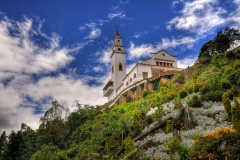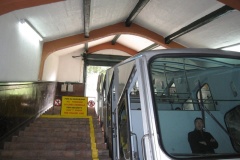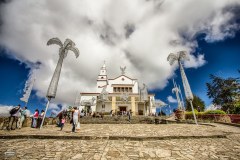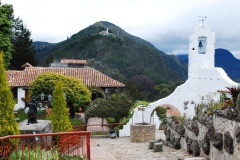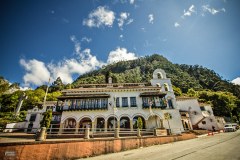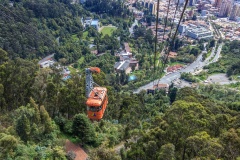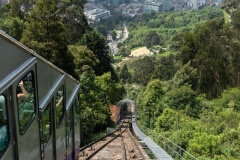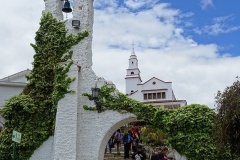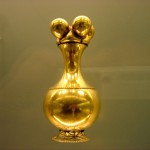Explore Bogotá’s famous Mount Monserrate on this free tour and find out all about its history as well as admire breathtaking views of the city!
When you lift up your eyes, from any point in the city, it is impossible not to see the hill that watches over Bogota from its 3152 m.a.s.L: Monserrate. It is the symbol for excellence of the Colombian capital. Not only as a natural image, but because of its religious character, whose sanctuary, millions of pilgrims and travelers have visited ever since it was founded in 1640.
Ever since that time, every day hundreds of believers devotedly climb the steps that lead to the sanctuary Monserrat in the summit, as an act of penitence; while other thousands of tourist, sportsmen of curious persons go by foot, in the funicular or by cable car and once again find the harmony that can exist between this creation of God and the works of man.To visit Monserrate for any reason is a unique experience; as well as the view you have there of Bogota, there for this purpose, its pilgrims, it gardens and fountains, its gastronomy, its misty forests, its sunsets, its star-lit nights and its majestic moon.
Thousands of pilgrims come in search of a miracle or just to attend the mass that is celebrated here every Sunday. The Señor Caido (Fallen Lord), beautifully sculpted from wood, is currently its most important attraction, along with the beautiful scenery that you can appreciate after climbing on foot, by cable car or funicular. © Cra,2 este No, 21-48 © (57+1) 284 57 00 0 www.cerramonserrate.com O Funicular: Monday to Saturday from 7:45 to 11:45 am,, Sundays apd public holidays from 5:30 am to 6 p.m, Cable car: Monday to Saturday from noon to 12 p.m, and Sundays from 6:30 am to 6 pm.

The Funicular: The funicular, that daily transports the capital dwellers and the tourists, was completed in 1928 and inaugurated on August 18,1929. Ever since that distant date, up to the present, this small train has slowly risen towards the summit of Monserrate, at a thrift pace which allows its passengers to contemplate nature and the city landscape which is gradually left behind as you climb up the 3152 m.a.s.l., where its last station is located. Different from the tramcars or trolley cars which have become museum pieces for the young people, the history of the Monserrate funicular is being written every day. Step by step, meter by meter, 3.2 meter for second, to be exact. Also, it is the “Cable car”, which is a great option to go up to the hill.
Flora: The high Andino forest is located between 2,750 and 3,200 m.a.s.l., with a temperature of 90 C and 120 C. It is characterized by high and dense vegetation with forests of encenillo and other species such as catch flies, gaque, cinnamon-colored hawthorn, myrtle and grape.
The lower Andean forest appears in the lower sides of the hills, between 2,550 and 2,750 m.a.s.l. It is formed by a great diversity of species, such as gum, mano de oso, trompeto, cedrillo, raque and a great variety of ferns, frailejones, bamboo, tagua and lichens, among others.
Fauna: Due to the burning, the felling of trees and the plantation of foreign species, such as the pine and the eucalyptus, most of the fauna that populate the forests has disappeared. Small mammals are found in the secondary sectors, such as forest mice, nectarous bats, marsupials, weasels and foxes and about 58 species of birds, that correspond to the high Andean forest.
In the low Andean forest there are some weasels, opossums and canids. As far as fowl, there are blackbirds, swallows, sparrow hawks, crested sparrows, cucaracheros and a variety of hummingbirds.
The sanctuary of Monserrate in the eastern hills of Bogotá, Colombia
Tours & Tickets in Bogotá Colombia
➡ Discover more about Colombia: Cali Colombia, is known by the rest Colombia as the “Rumba Capital” and by the world as the “Salsa Capital”
| BOGOTA TRAVEL GUIDE |
If you’re travelling to Bogotá Colombia, we help you:
Travel To Colombia – Tourism Website of Colombia
![]() General Information About Colombia: National symbols of Colombia – Colombia: living history – Geography of Colombia – Economy of Colombia – Languages of Colombia
General Information About Colombia: National symbols of Colombia – Colombia: living history – Geography of Colombia – Economy of Colombia – Languages of Colombia
![]() Practical information about Colombia: Climate – How to get to Colombia – Visa, Customs, Documentation and Taxes – Embassies and consulates in Colombia – Health and vaccination – Emergency numbers – Culture of Colombia – Measures and Electricity – Currency of Colombia
Practical information about Colombia: Climate – How to get to Colombia – Visa, Customs, Documentation and Taxes – Embassies and consulates in Colombia – Health and vaccination – Emergency numbers – Culture of Colombia – Measures and Electricity – Currency of Colombia
![]() Tourist Information about Colombia: General Information – Practical information about Colombia – Adventure Colombia – Hotels and accommodations in Colombia – How to Get to Colombia – Gastronomy in Colombia – Colombia’s Best Festivals and Carnivals – Tourist Attractions in Colombia – Foreign Embassies and Consulates in Colombia – Tips and advice for travel in Colombia – Top 10 Colombian Travel Destinations – Natural regions of Colombia – Cultural Tourism in Colombia – UNESCO Intangible Cultural Heritage Lists – UNESCO Heritage Sites in Colombia – Top 10 amazing places to visit in Colombia – Colombian Cuisine – Tourism of Nature
Tourist Information about Colombia: General Information – Practical information about Colombia – Adventure Colombia – Hotels and accommodations in Colombia – How to Get to Colombia – Gastronomy in Colombia – Colombia’s Best Festivals and Carnivals – Tourist Attractions in Colombia – Foreign Embassies and Consulates in Colombia – Tips and advice for travel in Colombia – Top 10 Colombian Travel Destinations – Natural regions of Colombia – Cultural Tourism in Colombia – UNESCO Intangible Cultural Heritage Lists – UNESCO Heritage Sites in Colombia – Top 10 amazing places to visit in Colombia – Colombian Cuisine – Tourism of Nature
Flights, Cheap Airfare Deals & Plane Tickets |

